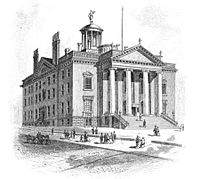36th New York State Legislature
| 36th New York State Legislature | |||||
|---|---|---|---|---|---|
|
|||||

The Old State Capitol (1879)
|
|||||
| Overview | |||||
| Jurisdiction | New York, United States | ||||
| Term | July 1, 1812 – June 30, 1813 | ||||
| Senate | |||||
| Members | 32 | ||||
| President | Lt. Gov. DeWitt Clinton (Dem.-Rep.) | ||||
| Party control | Clintonian (19-8-4) | ||||
| Assembly | |||||
| Members | 112 | ||||
| Speaker | Jacob R. Van Rensselaer (Fed.) | ||||
| Party control | Federalist (58-29-22) | ||||
| Sessions | |||||
|
|||||
| 1st | November 3 – 11, 1812 |
|---|---|
| 2nd | January 12 – April 13, 1813 |
The 36th New York State Legislature, consisting of the New York State Senate and the New York State Assembly, met from November 3, 1812, to April 13, 1813, during the sixth year of Daniel D. Tompkins's governorship, in Albany.
Under the provisions of the New York Constitution of 1777, amended by the Constitutional Convention of 1801, 32 Senators were elected on general tickets in the four senatorial districts for four-year terms. They were divided into four classes, and every year eight Senate seats came up for election. Assemblymen were elected countywide on general tickets to a one-year term, the whole Assembly being renewed annually.
In 1797, Albany was declared the State capital, and all subsequent Legislatures have been meeting there ever since. In 1799, the Legislature enacted that future Legislatures meet on the last Tuesday of January of each year unless called earlier by the governor.
At this time the politicians were divided into two opposing political parties: the Federalists and the Democratic-Republicans.
The State election was held from April 28 to 30, 1812. Senator Francis A. Bloodgood (Western D.) was re-elected. Elbert H. Jones (Southern D.), Martin Van Buren (Middle D.), Gerrit Wendell ( Eastern D.), Russell Attwater, Archibald S. Clarke (both Western D.); and Assemblymen Peter W. Radcliff (Southern D.) and Henry Hager (Western D.) were also elected to the Senate. Jones, Radcliff and Wendell were Federalists, the other five were Democratic-Republicans.
On May 28, a caucus of Dem.-Rep. legislators nominated DeWitt Clinton for U.S. President. On June 18, the United States declared War against Great Britain. The Federalists opposed the war; the Democratic-Republican Party split into two factions: the Clintonians (supporters of DeWitt Clinton and mostly opposed to the war) and the Madisonians (supporters of President James Madison and the war).
...
Wikipedia
